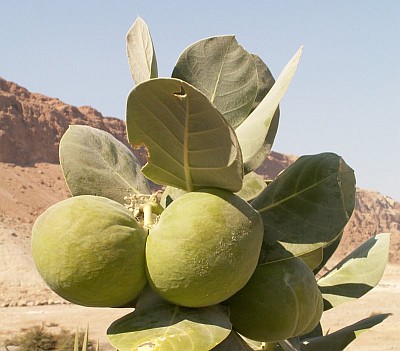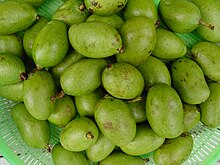Introduction:-
Arka is one of the herbs mentioned in all ancient scripts of Ayurveda. Dhanvantari Nighantu and Madanadi Nighantu have mentioned only two varieties of arka, namely : arka and alarka (rajarka). But Bhavaprakasa after describing two kinds of arka says that there is another variety called raktarka and describes its properties separately. The author of Raja Nighantu also enumerates three kinds of arka viz. arka, vetarka and rajarka and ascribes all of them separately.
However, only two varieties of arka are commonly met with, one with white flowers (Calotropis procera) and the other with lilac, rosy or purple tinted flowers (Calotropis gigantean). In Ayurvedic texts the white flowered varieties called alarka are said to be of superior quality, though all the commentators are of the opinion that either of these can be used with equal effect, as both have the same properties. Maharsi Caraka has categorized arka as bhedaniya- accumulation breaking herb, svedopaga – an adjunct to sweating therapy and vamanopaga – an adjunct to emesis (Caraka Samhita, Sutra, A-4). It is cited to be useful for external application, in ascites. (Astanga Sangraha, Cikitsa, 17).
Arka grows throughout India, especially in dry waste lands. It is a shrub reaching 3-5 metres in height, with thick twisted branches. The young branches are bluntly quadrangular and the bark is ash coloured, covered with a white woolly down. The leaves are large, opposite, spreading, decussate, whitish green in colour, 10-15 cm long and 3-7 cm broad. They resemble to those of banyan tree. The flowers are rather large, beautiful lilac or purple tinged, arranged in umbellate corymbs on erect cylindrical stout peduncles. The fruits are short, stout peduncles. The fruits are short, ovoid, curved, thick, fleshy follicles covered with white woolly pubescence.
As mentioned above, the white flowered variety is botanically named as Calotropis procera and the other with lilac, rosy or purple tinted flowers as Calotropis gigantean. They belong to family Asclepiadaceae. From the leaves of Calotropis procera, calotropin, calatoxin, uscharin and uscharidin have been isolated from latex. Calotropin shows digitalis like action on the heart, but its action is not cumulative and is less harmful. From the flowers, cyaniding – 3 rhamnoglucose and new triterpenecalotropenyl acetate is isolated. Lupeol is isolated from latex. Quercetin-3-rutinoside is identified in the roots, stem, leaves, flowers and latex. Voruscharin is isolated from African plant. Cardenolides contents in leaf (2.04 mg / g ) and in latex (162.0 mg/g) , mostly calotropagenin – derived cardenolides present from Calotropis gigantean, two triterpene esters – 3 methylbutanoates of amyrin and taraxasterol isolated from latex. Calotosin uscharin and calactin have been also identified
Properties :-
Arka is pungent and bitter in taste (rasa) pungent in the post digestive effect and has hot potency (virya). The white flowered variety alleviates kapha and vata dosa. Whereas red variety alleviates kapha and pitta dosas. It possesses light (laghu), dry and sharp attributes. The chief properties of arka are emetic, purgative, appetizer, digestant, irritant, poisonous and abortificient. It is used in ascites, tumours and dermatoses. (Bhavaprakasa Nighantu)
Medicinal Uses :-
The root skin, latex, flowers, leaves and the ksara of arka are used for medicinal purpose. Arka is useful both, internally as well as externally. The poultice of its leaves effectively reduces the pain and swelling in rheumatic joints and filariasis. The medicated oil is beneficial in otitis and deafness; The topical sprinkle of dried leaves powder hastens the wound healing. In glandular swellings the topical application of latex reduces the inflammation. In skin diseases, associated with depigmentation, the latex combined with mustard oil, works well. The fomentation with its leaves, slightly warmed with thin coat of castor oil, is beneficial to relieve the abdominal pain. The local application of latex is recommended in hairfall and baldness. It also, is useful in piles. The latex also mitigates the dental aches.
Internally, arka is very useful many diseases, especially in ascites. The latex as a strong purgative and accumulations breaking imparts excellent results in ascites of kapha type and hepatosplenomegaly with ascites. To alleviate the oedema in such conditions, of kapha origin, the decoction of its roots combined with triphala and honey, is salutary. In asthma and cough, the flowers and the root skin of arka are commonly used. As a blood purifier, it is benevolent is filariasis and syphilis, The red flowers alleviate raktapitta. In chronic dermatoses, the root skin is recommended with honey.
The large doses of its latex and leaf juice produces toxic symptoms like burning in throat, irriation of the stomach, nausea, vomiting, diarrhoea, tremors, vertigo and convulsions. In these conditions, withdraw the use of arka or its preparations and advise the milk and ghee in diet.
Classical Ayurvedic Preparations
- Arkavaleha
- Arka taila
- Arkesvara
- Arkadi curna
- Ekangafira
- Sutikabha rana
- Mahavatavidhvamsa
- Pravala pancamrta
- Arkakolakanda vati etc.
Pharmacognostical studies on Calotropis procera (Ait.) R.Br.
Anita Kumari and Ashwani Kumar
Calotropis procera (Asclepiadaceae) is a wild shrub, which grows upto a height of 1-3 m and its leaves are 10-13 cm wide by 17-19 cm long. Calotropis procera commonly known as Akra is a popular medicinal plant. This plant is very drought resistant and grows throughout the Sahelian countries, notably in Burkina Faso.
Medicinal properties:
Its latex is used in leprosy, eczema, inflamation, cutaneous infections, syphilis, malarial and low hectic fevers, and as abortifacient ( Kumar and Basu, 1994). Leaves: in rheumatism, as an anti-inflmmatory and antimicrobial and Roots: as hepatoprotective agents, against colds and coughs, syphlis and elephantiasis, as an anti-inflammatory, analgesic, antimalarial and antimicrobial. Flowers: as cytostatic, arbortifacient and antimalarial, in asthama and piles and villagers in Bikaner district ingest almost all plant parts in various dietary combinations for malarial fevers and pyrexias (Sharma and Sharma, 2000).
Dried latex and chloroform extract of roots has been reported to possess anti-inflamatory activity ( Kumar and Basu, 1994). Aqueous extract of the flowers has been found to exhibit analgesic, antipyretic and anti-inflammatory activity. The alcoholic extract from different parts has been found to possess antimicrobial and spermicical activity (Kamath and Rana, 2002).
Anti-iflamatory property of the latex of Calotropis procera was studied on crrageenin and formalin induced rat raw oedema model. A single dose of the aqueous suspension of dried latex was effective to a significant level against acute inflammatory response ( Basu and Nag Chaudhri, 1991)
Anti-pest activity: mosquito control by Calotropis latex has been reported by Girdhar et al (1984), The effect of crude fractions of C. procera, ist flowers, buds and root were tested against a chloroquine sensitive strain, MRC 20 and a chloroquine resistant strain, MRC 76 of Plasmodium falciparum ( Sharma and Sharma, 1999).
Traditional uses:
Anti-diarrhoel effects of C.gigantea used traditionally in Indian system of medicine were recorded. The remarkable anti-diarrhoel effect of C. gigantea extract against castor oil-induced diarrhoel model attests to ist utility in a wide range of diarrhoel states ( Chitme et al 2004).
Enzymes:
The plant contains several useful enzymes. A protease was purified to homogeneity from the latex of medicinal plant Calotropis procera. The enzyme hydrolyses denatured natural substances like casein, azoalbumin, and azocasein with high specific activity.
Anti-microbial activity:
It has been shown to have anti-bacterial properties against Gram positive bacteria and two gram negative bacteria.
Global use in traditional medicinal system:
The decoction of the aerial part of Calotropis procera is commonly used in Saudi Arabian traditional medicines for the treatment of variety of diseases including fever, joint pain, muscular spasm and constipation. The phytochemical studies showed the presence of alkaloids, cardiac glycosides, tannins, flavonoids, sterols and /or triterpenes. In parts of West Africa, including Nigeria and Republic of Benin, the juice from the leaves of the Sodom apple (C.procera) is used for traditional cheese-making ( Ogundiwin and Oke, 1983). Recently partially purified milk clotting enyzme has been extracted from Sodom apple leaves (Aworh and Nakai, 1986). Chemical composition and texture profile of cheese made with vegetable rennet from Calotropis procera (Sodom applie) leaves were compared with those of a direct acid cheese made with calf rennet. Relative to that made with calf rennet, cheese made with vegetable rennet was harder, less cohesive and more gummy, presumably because of differences in chemical composition and physical characteristics between the cheeses. (Aworh and Muller, 1987).
Anita Kumari and Ashwani Kumar
Calotropis procera (Asclepiadaceae) is a wild shrub, which grows upto a height of 1-3 m and its leaves are 10-13 cm wide by 17-19 cm long. Calotropis procera commonly known as Akra is a popular medicinal plant. This plant is very drought resistant and grows throughout the Sahelian countries, notably in Burkina Faso.
Medicinal properties:
Its latex is used in leprosy, eczema, inflamation, cutaneous infections, syphilis, malarial and low hectic fevers, and as abortifacient ( Kumar and Basu, 1994). Leaves: in rheumatism, as an anti-inflmmatory and antimicrobial and Roots: as hepatoprotective agents, against colds and coughs, syphlis and elephantiasis, as an anti-inflammatory, analgesic, antimalarial and antimicrobial. Flowers: as cytostatic, arbortifacient and antimalarial, in asthama and piles and villagers in Bikaner district ingest almost all plant parts in various dietary combinations for malarial fevers and pyrexias (Sharma and Sharma, 2000).
Dried latex and chloroform extract of roots has been reported to possess anti-inflamatory activity ( Kumar and Basu, 1994). Aqueous extract of the flowers has been found to exhibit analgesic, antipyretic and anti-inflammatory activity. The alcoholic extract from different parts has been found to possess antimicrobial and spermicical activity (Kamath and Rana, 2002).
Anti-iflamatory property of the latex of Calotropis procera was studied on crrageenin and formalin induced rat raw oedema model. A single dose of the aqueous suspension of dried latex was effective to a significant level against acute inflammatory response ( Basu and Nag Chaudhri, 1991)
Anti-pest activity: mosquito control by Calotropis latex has been reported by Girdhar et al (1984), The effect of crude fractions of C. procera, ist flowers, buds and root were tested against a chloroquine sensitive strain, MRC 20 and a chloroquine resistant strain, MRC 76 of Plasmodium falciparum ( Sharma and Sharma, 1999).
Traditional uses:
Anti-diarrhoel effects of C.gigantea used traditionally in Indian system of medicine were recorded. The remarkable anti-diarrhoel effect of C. gigantea extract against castor oil-induced diarrhoel model attests to ist utility in a wide range of diarrhoel states ( Chitme et al 2004).
Enzymes:
The plant contains several useful enzymes. A protease was purified to homogeneity from the latex of medicinal plant Calotropis procera. The enzyme hydrolyses denatured natural substances like casein, azoalbumin, and azocasein with high specific activity.
Anti-microbial activity:
It has been shown to have anti-bacterial properties against Gram positive bacteria and two gram negative bacteria.
Global use in traditional medicinal system:
The decoction of the aerial part of Calotropis procera is commonly used in Saudi Arabian traditional medicines for the treatment of variety of diseases including fever, joint pain, muscular spasm and constipation. The phytochemical studies showed the presence of alkaloids, cardiac glycosides, tannins, flavonoids, sterols and /or triterpenes. In parts of West Africa, including Nigeria and Republic of Benin, the juice from the leaves of the Sodom apple (C.procera) is used for traditional cheese-making ( Ogundiwin and Oke, 1983). Recently partially purified milk clotting enyzme has been extracted from Sodom apple leaves (Aworh and Nakai, 1986). Chemical composition and texture profile of cheese made with vegetable rennet from Calotropis procera (Sodom applie) leaves were compared with those of a direct acid cheese made with calf rennet. Relative to that made with calf rennet, cheese made with vegetable rennet was harder, less cohesive and more gummy, presumably because of differences in chemical composition and physical characteristics between the cheeses. (Aworh and Muller, 1987).




 PawPaw tree.
PawPaw tree.



